sensor MITSUBISHI OUTLANDER PHEV 2018 (in English) Owner's Guide
[x] Cancel search | Manufacturer: MITSUBISHI, Model Year: 2018, Model line: OUTLANDER PHEV, Model: MITSUBISHI OUTLANDER PHEV 2018Pages: 538, PDF Size: 25.01 MB
Page 198 of 538
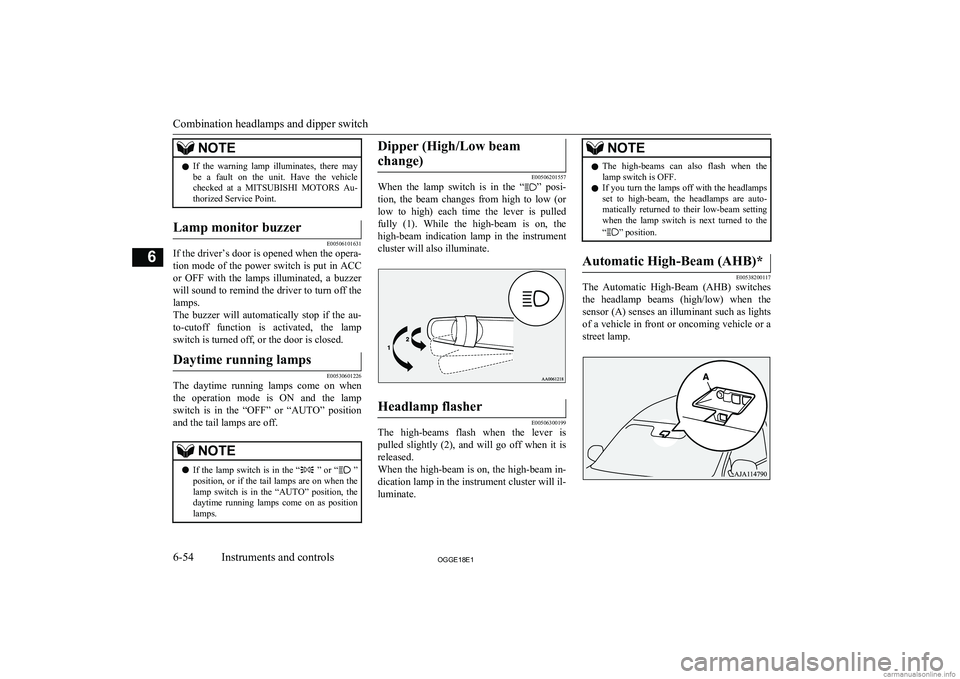
NOTElIf the warning lamp illuminates, there may
be a fault on the unit. Have the vehicle
checked at a MITSUBISHI MOTORS Au-
thorized Service Point.Lamp monitor buzzer
E00506101631
If the driver’s door is opened when the opera-
tion mode of the power switch is put in ACCor OFF with the lamps illuminated, a buzzer
will sound to remind the driver to turn off the
lamps.
The buzzer will automatically stop if the au- to-cutoff function is activated, the lamp switch is turned off, or the door is closed.
Daytime running lamps
E00530601226
The daytime running lamps come on when
the operation mode is ON and the lamp switch is in the “OFF” or “AUTO” position
and the tail lamps are off.
NOTEl If the lamp switch is in the “ ” or “
”
position, or if the tail lamps are on when the
lamp switch is in the “AUTO” position, the daytime running lamps come on as positionlamps.Dipper (High/Low beam
change)
E00506201557
When the lamp switch is in the “” posi-
tion, the beam changes from high to low (or
low to high) each time the lever is pulled fully (1). While the high-beam is on, the
high-beam indication lamp in the instrument
cluster will also illuminate.
Headlamp flasher
E00506300199
The high-beams flash when the lever is pulled slightly (2), and will go off when it is
released.
When the high-beam is on, the high-beam in- dication lamp in the instrument cluster will il-
luminate.
NOTEl The high-beams can also flash when the
lamp switch is OFF.
l If you turn the lamps off with the headlamps
set to high-beam, the headlamps are auto- matically returned to their low-beam setting
when the lamp switch is next turned to the
“
” position.
Automatic High-Beam (AHB)*
E00538200117
The Automatic High-Beam (AHB) switches
the headlamp beams (high/low) when the
sensor (A) senses an illuminant such as lights of a vehicle in front or oncoming vehicle or a
street lamp.
Combination headlamps and dipper switch
6-54OGGE18E1Instruments and controls6
Page 200 of 538
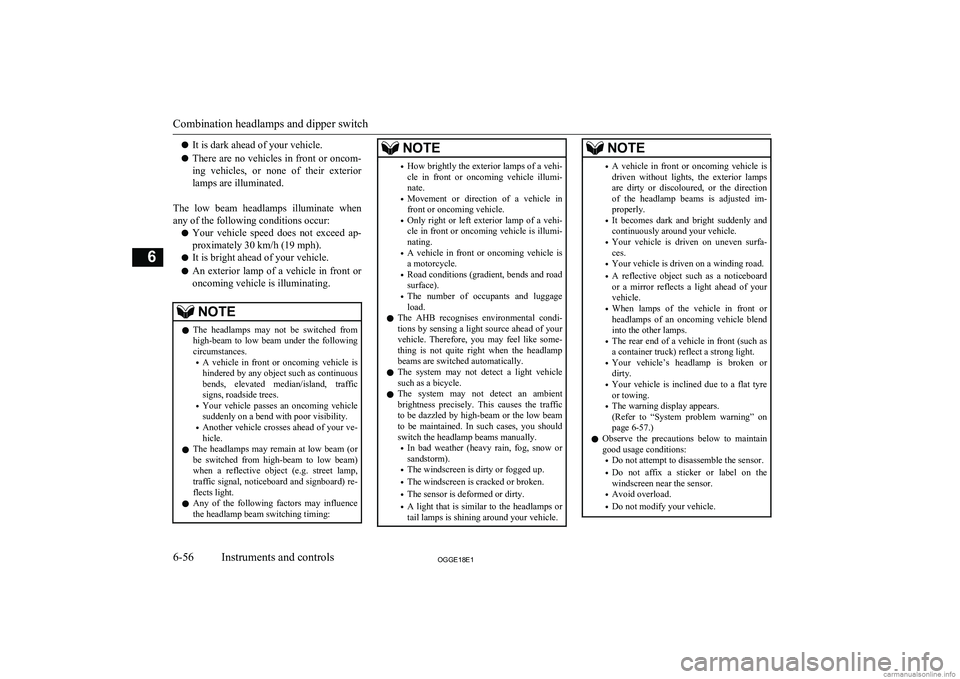
lIt is dark ahead of your vehicle.
l There are no vehicles in front or oncom-
ing vehicles, or none of their exterior
lamps are illuminated.
The low beam headlamps illuminate when any of the following conditions occur:
l Your vehicle speed does not exceed ap-
proximately 30 km/h (19 mph).
l It is bright ahead of your vehicle.
l An exterior lamp of a vehicle in front or
oncoming vehicle is illuminating.NOTEl The headlamps may not be switched from
high-beam to low beam under the following circumstances.
• A vehicle in front or oncoming vehicle is
hindered by any object such as continuous
bends, elevated median/island, traffic
signs, roadside trees.
• Your vehicle passes an oncoming vehicle
suddenly on a bend with poor visibility.
• Another vehicle crosses ahead of your ve-
hicle.
l The headlamps may remain at low beam (or
be switched from high-beam to low beam)
when a reflective object (e.g. street lamp,
traffic signal, noticeboard and signboard) re- flects light.
l Any of the following factors may influence
the headlamp beam switching timing:NOTE• How brightly the exterior lamps of a vehi-
cle in front or oncoming vehicle illumi-
nate.
• Movement or direction of a vehicle in
front or oncoming vehicle.
• Only right or left exterior lamp of a vehi-
cle in front or oncoming vehicle is illumi-
nating.
• A vehicle in front or oncoming vehicle is
a motorcycle.
• Road conditions (gradient, bends and road
surface).
• The number of occupants and luggage
load.
l The AHB recognises environmental condi-
tions by sensing a light source ahead of your
vehicle. Therefore, you may feel like some- thing is not quite right when the headlamp
beams are switched automatically.
l The system may not detect a light vehicle
such as a bicycle.
l The system may not detect an ambient
brightness precisely. This causes the traffic to be dazzled by high-beam or the low beam to be maintained. In such cases, you should
switch the headlamp beams manually.
• In bad weather (heavy rain, fog, snow or
sandstorm).
• The windscreen is dirty or fogged up.
• The windscreen is cracked or broken.
• The sensor is deformed or dirty.
• A light that is similar to the headlamps or
tail lamps is shining around your vehicle.NOTE• A vehicle in front or oncoming vehicle is
driven without lights, the exterior lamps are dirty or discoloured, or the direction
of the headlamp beams is adjusted im- properly.
• It becomes dark and bright suddenly and
continuously around your vehicle.
• Your vehicle is driven on uneven surfa-
ces.
• Your vehicle is driven on a winding road.
• A reflective object such as a noticeboard
or a mirror reflects a light ahead of your vehicle.
• When lamps of the vehicle in front or
headlamps of an oncoming vehicle blend into the other lamps.
• The rear end of a vehicle in front (such as
a container truck) reflect a strong light.
• Your vehicle’s headlamp is broken or
dirty.
• Your vehicle is inclined due to a flat tyre
or towing.
• The warning display appears.
(Refer to “System problem warning” on
page 6-57.)
l Observe the precautions below to maintain
good usage conditions:
• Do not attempt to disassemble the sensor.
• Do not affix a sticker or label on the
windscreen near the sensor.
• Avoid overload.
• Do not modify your vehicle.
Combination headlamps and dipper switch
6-56OGGE18E1Instruments and controls6
Page 201 of 538
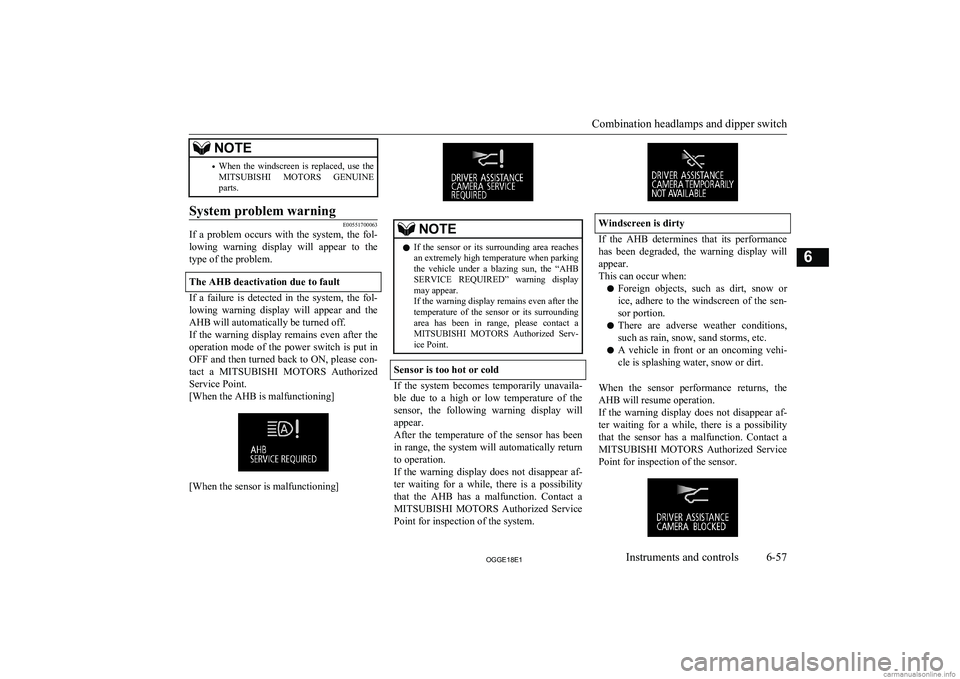
NOTE•When the windscreen is replaced, use the
MITSUBISHI MOTORS GENUINE
parts.System problem warning
E00551700063
If a problem occurs with the system, the fol-
lowing warning display will appear to the
type of the problem.
The AHB deactivation due to fault
If a failure is detected in the system, the fol-
lowing warning display will appear and the AHB will automatically be turned off.
If the warning display remains even after the operation mode of the power switch is put in
OFF and then turned back to ON, please con- tact a MITSUBISHI MOTORS Authorized
Service Point.
[When the AHB is malfunctioning]
[When the sensor is malfunctioning]
NOTEl If the sensor or its surrounding area reaches
an extremely high temperature when parking the vehicle under a blazing sun, the “AHBSERVICE REQUIRED” warning display
may appear.
If the warning display remains even after the temperature of the sensor or its surrounding area has been in range, please contact a
MITSUBISHI MOTORS Authorized Serv-
ice Point.
Sensor is too hot or cold
If the system becomes temporarily unavaila-
ble due to a high or low temperature of thesensor, the following warning display will
appear.
After the temperature of the sensor has been
in range, the system will automatically return
to operation.
If the warning display does not disappear af- ter waiting for a while, there is a possibilitythat the AHB has a malfunction. Contact aMITSUBISHI MOTORS Authorized Service
Point for inspection of the system.
Windscreen is dirty
If the AHB determines that its performance
has been degraded, the warning display will appear.
This can occur when:
l Foreign objects, such as dirt, snow or
ice, adhere to the windscreen of the sen-
sor portion.
l There are adverse weather conditions,
such as rain, snow, sand storms, etc.
l A vehicle in front or an oncoming vehi-
cle is splashing water, snow or dirt.
When the sensor performance returns, the
AHB will resume operation.
If the warning display does not disappear af- ter waiting for a while, there is a possibility
that the sensor has a malfunction. Contact a MITSUBISHI MOTORS Authorized Service
Point for inspection of the sensor.
Combination headlamps and dipper switch
6-57OGGE18E1Instruments and controls6
Page 207 of 538
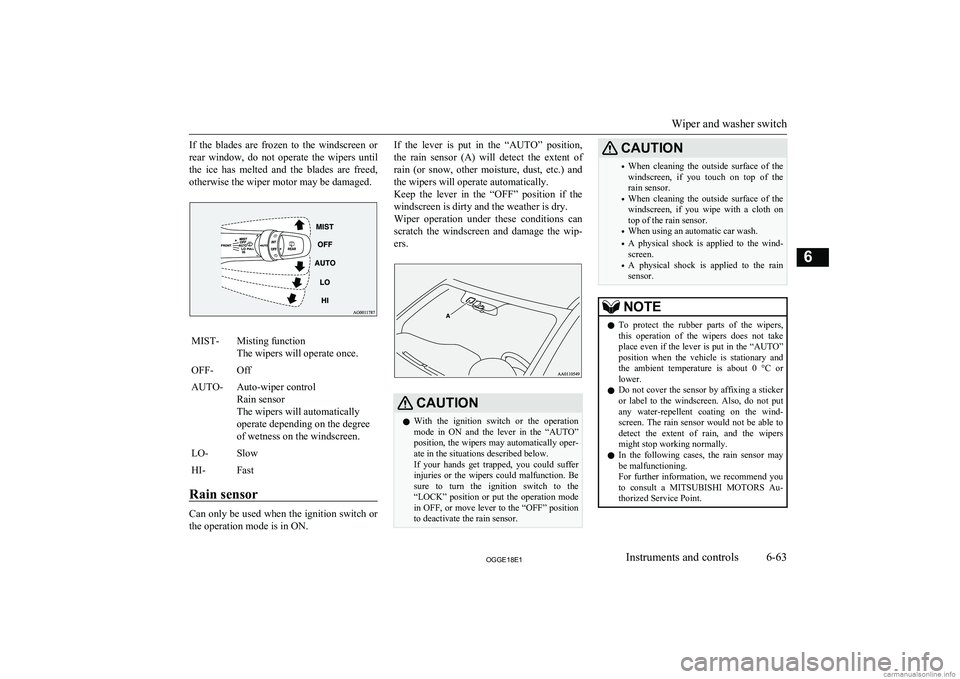
If the blades are frozen to the windscreen or
rear window, do not operate the wipers until the ice has melted and the blades are freed,
otherwise the wiper motor may be damaged.MIST-Misting function
The wipers will operate once.OFF-OffAUTO-Auto-wiper control
Rain sensor
The wipers will automatically
operate depending on the degree
of wetness on the windscreen.LO-SlowHI-Fast
Rain sensor
Can only be used when the ignition switch or the operation mode is in ON.
If the lever is put in the “AUTO” position,
the rain sensor (A) will detect the extent of rain (or snow, other moisture, dust, etc.) and the wipers will operate automatically.
Keep the lever in the “OFF” position if the
windscreen is dirty and the weather is dry.
Wiper operation under these conditions can scratch the windscreen and damage the wip-
ers.CAUTIONl With the ignition switch or the operation
mode in ON and the lever in the “AUTO”
position, the wipers may automatically oper-
ate in the situations described below.
If your hands get trapped, you could suffer injuries or the wipers could malfunction. Be sure to turn the ignition switch to the
“LOCK” position or put the operation mode
in OFF, or move lever to the “OFF” position to deactivate the rain sensor.CAUTION• When cleaning the outside surface of the
windscreen, if you touch on top of the
rain sensor.
• When cleaning the outside surface of the
windscreen, if you wipe with a cloth on
top of the rain sensor.
• When using an automatic car wash.
• A physical shock is applied to the wind-
screen.
• A physical shock is applied to the rain
sensor.NOTEl To protect the rubber parts of the wipers,
this operation of the wipers does not take
place even if the lever is put in the “AUTO” position when the vehicle is stationary and
the ambient temperature is about 0 °C or lower.
l Do not cover the sensor by affixing a sticker
or label to the windscreen. Also, do not put any water-repellent coating on the wind-screen. The rain sensor would not be able to
detect the extent of rain, and the wipers
might stop working normally.
l In the following cases, the rain sensor may
be malfunctioning.
For further information, we recommend you
to consult a MITSUBISHI MOTORS Au-
thorized Service Point.
Wiper and washer switch
6-63OGGE18E1Instruments and controls6
Page 208 of 538
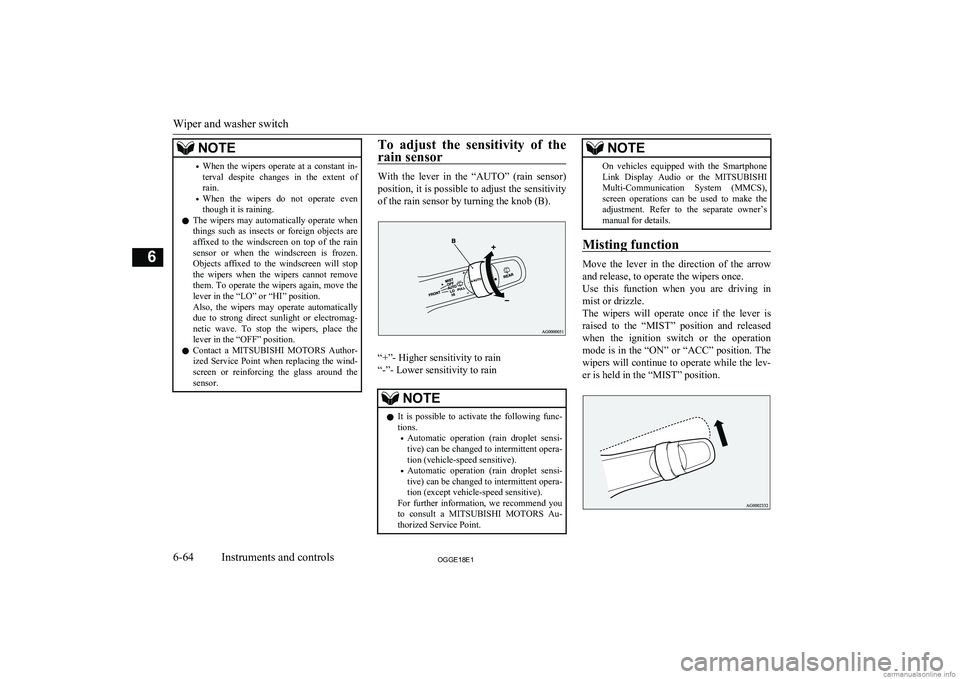
NOTE•When the wipers operate at a constant in-
terval despite changes in the extent of rain.
• When the wipers do not operate even
though it is raining.
l The wipers may automatically operate when
things such as insects or foreign objects are affixed to the windscreen on top of the rainsensor or when the windscreen is frozen.
Objects affixed to the windscreen will stop
the wipers when the wipers cannot remove them. To operate the wipers again, move the
lever in the “LO” or “HI” position.
Also, the wipers may operate automatically
due to strong direct sunlight or electromag- netic wave. To stop the wipers, place thelever in the “OFF” position.
l Contact a
MITSUBISHI MOTORS Author-
ized Service Point when replacing the wind-
screen or reinforcing the glass around the sensor.To adjust the sensitivity of the
rain sensor
With the lever in the “AUTO” (rain sensor) position, it is possible to adjust the sensitivityof the rain sensor by turning the knob (B).
“+”- Higher sensitivity to rain
“-”- Lower sensitivity to rain
NOTEl It is possible to activate the following func-
tions.
• Automatic operation (rain droplet sensi-
tive) can be changed to intermittent opera-
tion (vehicle-speed sensitive).
• Automatic operation (rain droplet sensi-
tive) can be changed to intermittent opera-
tion (except vehicle-speed sensitive).
For further information, we recommend you to consult a MITSUBISHI MOTORS Au-
thorized Service Point.NOTEOn vehicles equipped with the Smartphone
Link Display Audio or the MITSUBISHI
Multi-Communication System (MMCS), screen operations can be used to make theadjustment. Refer to the separate owner’s
manual for details.
Misting function
Move the lever in the direction of the arrow
and release, to operate the wipers once.
Use this function when you are driving in
mist or drizzle.
The wipers will operate once if the lever is raised to the “MIST” position and released
when the ignition switch or the operation
mode is in the “ON” or “ACC” position. The wipers will continue to operate while the lev- er is held in the “MIST” position.
Wiper and washer switch
6-64OGGE18E1Instruments and controls6
Page 215 of 538
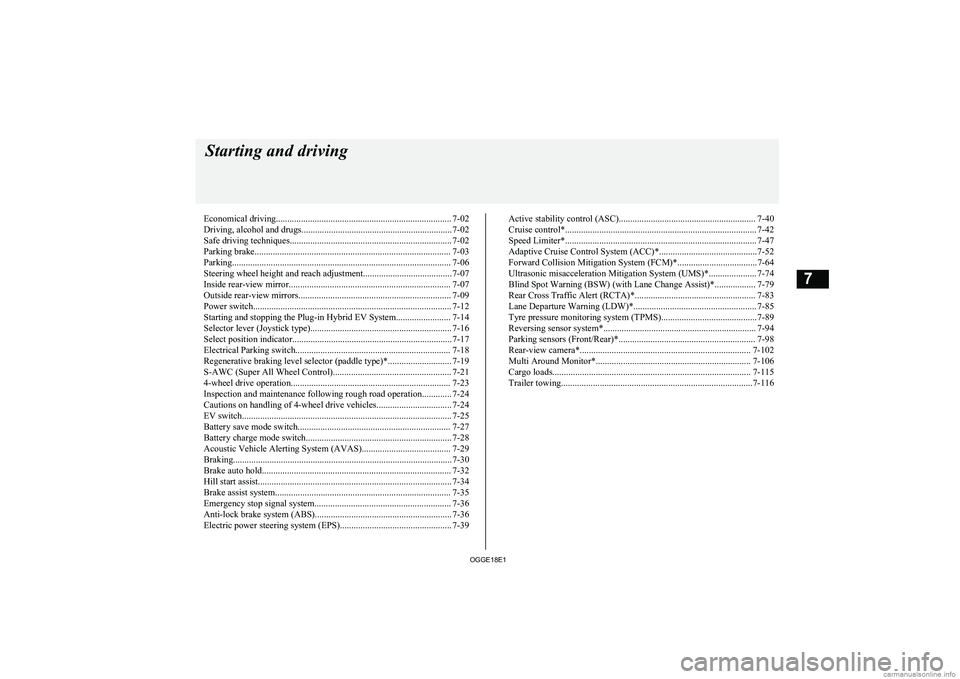
Economical driving............................................................................. 7-02
Driving, alcohol and drugs.................................................................. 7-02
Safe driving techniques....................................................................... 7-02
Parking brake...................................................................................... 7-03 Parking................................................................................................ 7-06
Steering wheel height and reach adjustment....................................... 7-07
Inside rear-view mirror....................................................................... 7-07
Outside rear-view mirrors................................................................... 7-09
Power switch....................................................................................... 7-12 Starting and stopping the Plug-in Hybrid EV System........................ 7-14
Selector lever (Joystick type).............................................................. 7-16 Select position indicator...................................................................... 7-17
Electrical Parking switch.................................................................... 7-18
Regenerative braking level selector (paddle type)*............................ 7-19
S-AWC (Super All Wheel Control).................................................... 7-21
4-wheel drive operation...................................................................... 7-23
Inspection and maintenance following rough road operation............. 7-24
Cautions on handling of 4-wheel drive vehicles................................. 7-24
EV switch............................................................................................ 7-25
Battery save mode switch................................................................... 7-27
Battery charge mode switch................................................................ 7-28 Acoustic Vehicle Alerting System (AVAS)....................................... 7-29
Braking................................................................................................ 7-30
Brake auto hold................................................................................... 7-32
Hill start assist..................................................................................... 7-34
Brake assist system............................................................................. 7-35
Emergency stop signal system............................................................ 7-36
Anti-lock brake system (ABS)............................................................ 7-36
Electric power steering system (EPS)................................................. 7-39Active stability control (ASC)............................................................ 7-40
Cruise control*.................................................................................... 7-42
Speed Limiter*.................................................................................... 7-47
Adaptive Cruise Control System (ACC)*...........................................7-52 Forward Collision Mitigation System (FCM)*...................................7-64Ultrasonic misacceleration Mitigation System (UMS)*..................... 7-74Blind Spot Warning (BSW) (with Lane Change Assist)*.................. 7-79
Rear Cross Traffic Alert (RCTA)*..................................................... 7-83Lane Departure Warning (LDW)*...................................................... 7-85
Tyre pressure monitoring system (TPMS).......................................... 7-89 Reversing sensor system*................................................................... 7-94
Parking sensors (Front/Rear)*............................................................ 7-98
Rear-view camera*........................................................................... 7-102 Multi Around Monitor*.................................................................... 7-106
Cargo loads....................................................................................... 7-115 Trailer towing....................................................................................7-116Starting and driving
OGGE18E17
Page 223 of 538
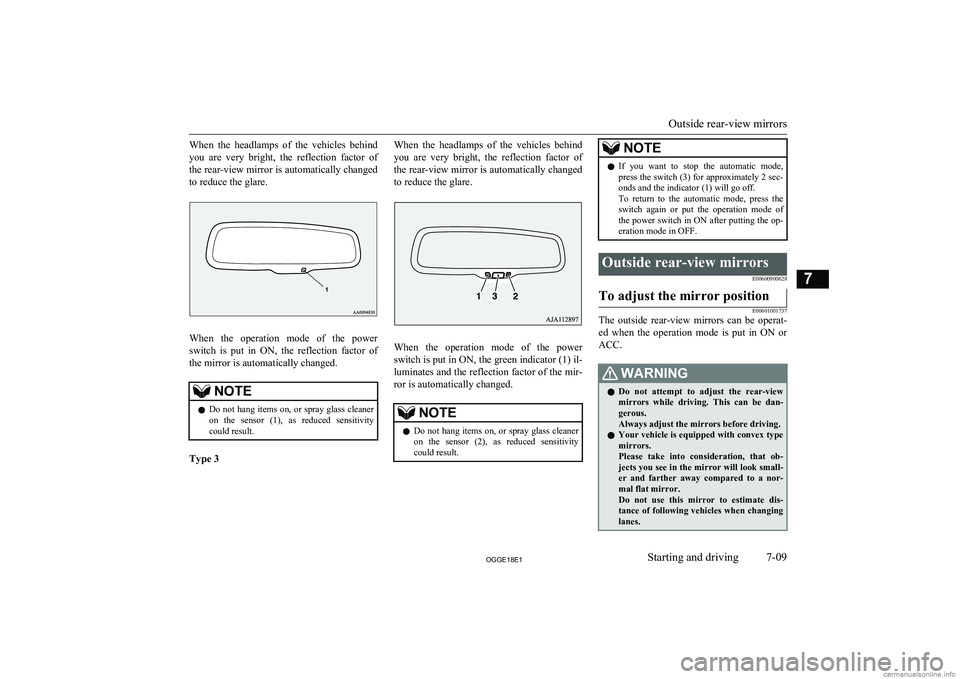
When the headlamps of the vehicles behindyou are very bright, the reflection factor ofthe rear-view mirror is automatically changed
to reduce the glare.
When the operation mode of the power
switch is put in ON, the reflection factor of the mirror is automatically changed.
NOTEl Do not hang items on, or spray glass cleaner
on the sensor (1), as reduced sensitivitycould result.
Type 3
When the headlamps of the vehicles behind
you are very bright, the reflection factor ofthe rear-view mirror is automatically changed
to reduce the glare.
When the operation mode of the power
switch is put in ON, the green indicator (1) il- luminates and the reflection factor of the mir-ror is automatically changed.
NOTEl Do not hang items on, or spray glass cleaner
on the sensor (2), as reduced sensitivitycould result.NOTEl If you want to stop the automatic mode,
press the switch (3) for approximately 2 sec- onds and the indicator (1) will go off.
To return to the automatic mode, press the
switch again or put the operation mode of the power switch in ON after putting the op- eration mode in OFF.Outside rear-view mirrors
E00600900628To adjust the mirror position
E00601001737
The outside rear-view mirrors can be operat-
ed when the operation mode is put in ON or ACC.
WARNINGl Do not attempt to adjust the rear-view
mirrors while driving. This can be dan-
gerous.
Always adjust the mirrors before driving.
l Your vehicle is equipped with convex type
mirrors.
Please take into consideration, that ob- jects you see in the mirror will look small-er and farther away compared to a nor-
mal flat mirror.
Do not use this mirror to estimate dis- tance of following vehicles when changing lanes.
Outside rear-view mirrors
7-09OGGE18E1Starting and driving7
Page 253 of 538
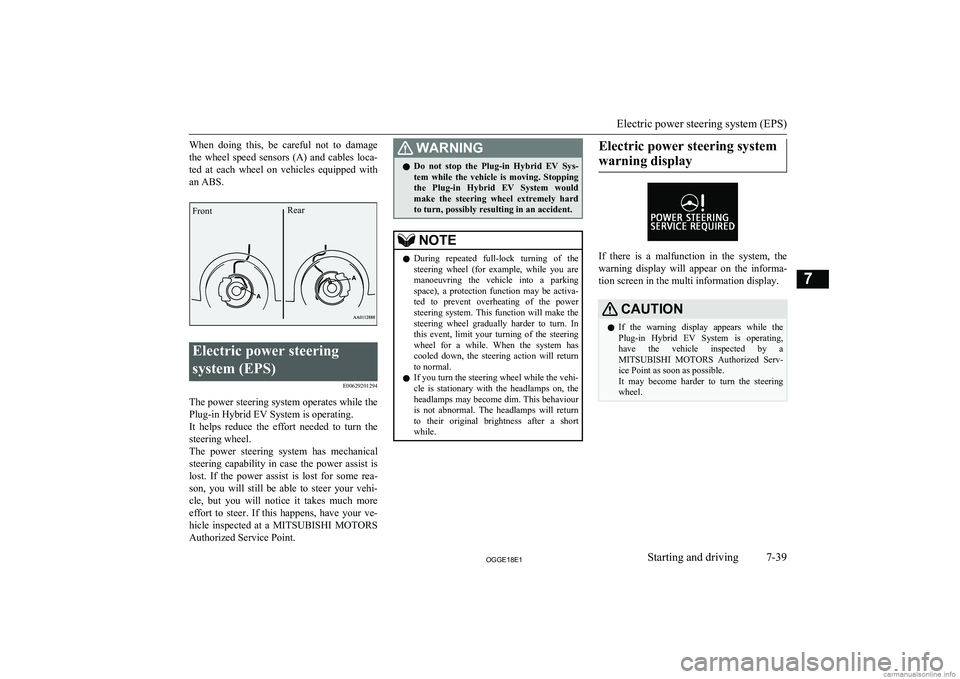
When doing this, be careful not to damagethe wheel speed sensors (A) and cables loca-ted at each wheel on vehicles equipped with an ABS.Electric power steering
system (EPS) E00629201294
The power steering system operates while thePlug-in Hybrid EV System is operating.
It helps reduce the effort needed to turn the steering wheel.
The power steering system has mechanical
steering capability in case the power assist is lost. If the power assist is lost for some rea-
son, you will still be able to steer your vehi-
cle, but you will notice it takes much more
effort to steer. If this happens, have your ve- hicle inspected at a MITSUBISHI MOTORS
Authorized Service Point.
WARNINGl Do not stop the Plug-in Hybrid EV Sys-
tem while the vehicle is moving. Stopping the Plug-in Hybrid EV System would
make the steering wheel extremely hard to turn, possibly resulting in an accident.NOTEl During repeated full-lock turning of the
steering wheel (for example, while you are manoeuvring the vehicle into a parking space), a protection function may be activa-
ted to prevent overheating of the power steering system. This function will make the
steering wheel gradually harder to turn. In
this event, limit your turning of the steering wheel for a while. When the system has
cooled down, the steering action will return to normal.
l If you turn the steering wheel while the vehi-
cle is stationary with the headlamps on, the
headlamps may become dim. This behaviour is not abnormal. The headlamps will returnto their original brightness after a shortwhile.Electric power steering system
warning display
If there is a malfunction in the system, the warning display will appear on the informa-
tion screen in the multi information display.
CAUTIONl If the warning display appears while the
Plug-in Hybrid EV System is operating,
have the vehicle inspected by a
MITSUBISHI MOTORS Authorized Serv-
ice Point as soon as possible.
It may become harder to turn the steering wheel.
Electric power steering system (EPS)
7-39OGGE18E1Starting and driving7FrontRear
Page 266 of 538
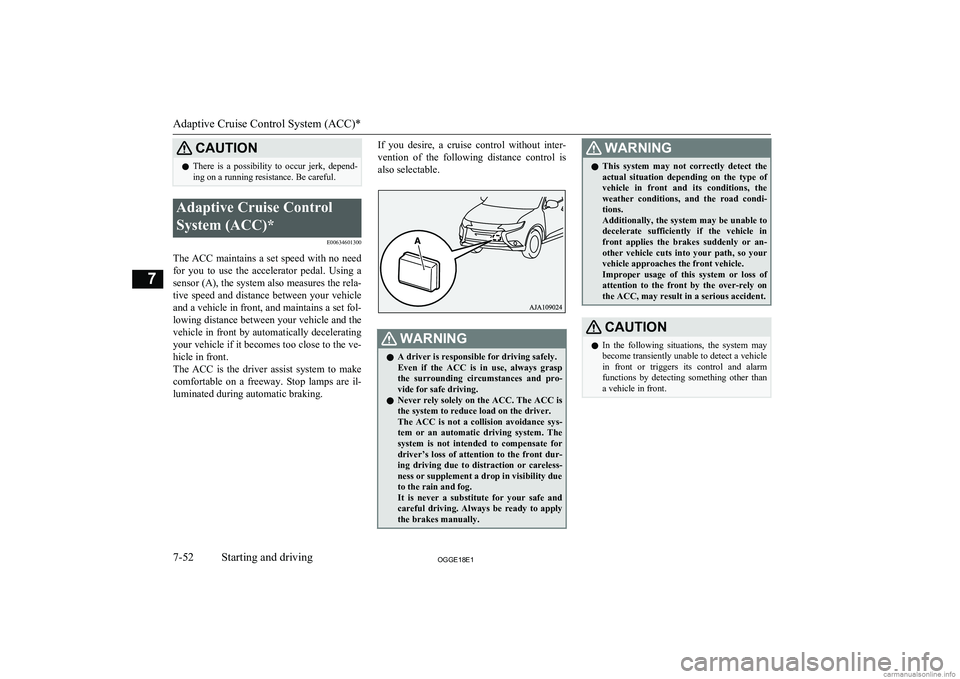
CAUTIONlThere is a possibility to occur jerk, depend-
ing on a running resistance. Be careful.Adaptive Cruise Control
System (ACC)* E00634601300
The ACC maintains a set speed with no needfor you to use the accelerator pedal. Using a
sensor (A), the system also measures the rela- tive speed and distance between your vehicle
and a vehicle in front, and maintains a set fol- lowing distance between your vehicle and thevehicle in front by automatically decelerating
your vehicle if it becomes too close to the ve-
hicle in front.
The ACC is the driver assist system to make comfortable on a freeway. Stop lamps are il-luminated during automatic braking.
If you desire, a cruise control without inter-
vention of the following distance control is
also selectable.WARNINGl A driver is responsible for driving safely.
Even if the ACC is in use, always grasp the surrounding circumstances and pro- vide for safe driving.
l Never rely solely on the ACC. The ACC is
the system to reduce load on the driver.
The ACC is not a collision avoidance sys- tem or an automatic driving system. The
system is not intended to compensate for driver’s loss of attention to the front dur-
ing driving due to distraction or careless-
ness or supplement a drop in visibility due
to the rain and fog.
It is never a substitute for your safe and careful driving. Always be ready to apply
the brakes manually.WARNINGl This system may not correctly detect the
actual situation depending on the type of
vehicle in front and its conditions, the weather conditions, and the road condi-
tions.
Additionally, the system may be unable to decelerate sufficiently if the vehicle infront applies the brakes suddenly or an-
other vehicle cuts into your path, so your vehicle approaches the front vehicle.
Improper usage of this system or loss of attention to the front by the over-rely on
the ACC, may result in a serious accident.CAUTIONl In the following situations, the system may
become transiently unable to detect a vehicle in front or triggers its control and alarm
functions by detecting something other than a vehicle in front.
Adaptive Cruise Control System (ACC)*
7-52OGGE18E1Starting and driving7
Page 267 of 538
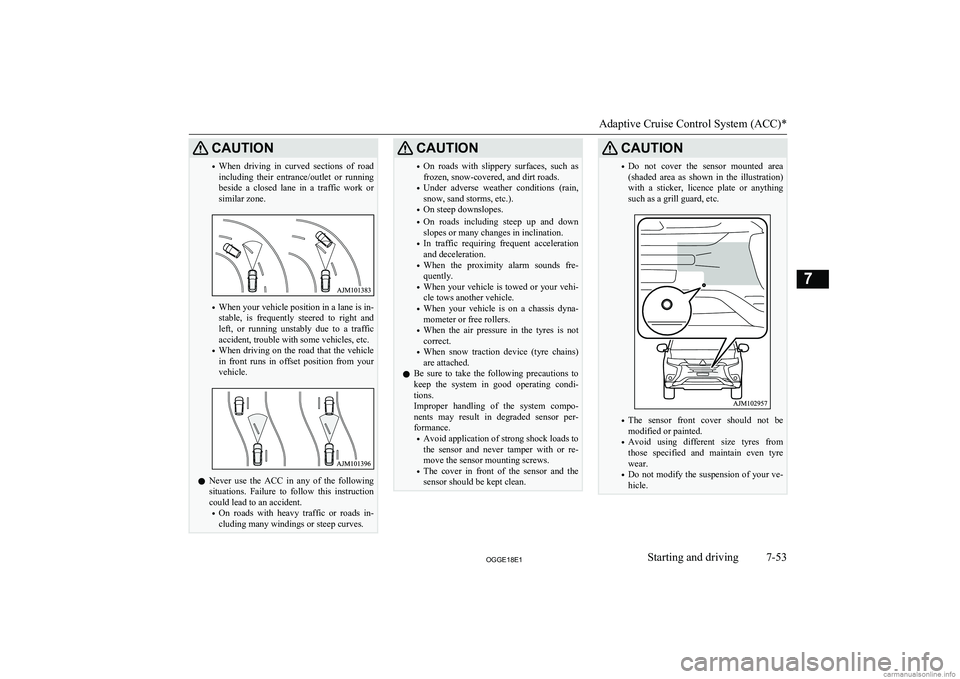
CAUTION•When driving in curved sections of road
including their entrance/outlet or running beside a closed lane in a traffic work or
similar zone.
• When your vehicle position in a lane is in-
stable, is frequently steered to right and left, or running unstably due to a trafficaccident, trouble with some vehicles, etc.
• When driving on the road that the vehicle
in front runs in offset position from your
vehicle.
l Never use the ACC in any of the following
situations. Failure to follow this instructioncould lead to an accident.
• On roads with heavy traffic or roads in-
cluding many windings or steep curves.
CAUTION• On roads with slippery surfaces, such as
frozen, snow-covered, and dirt roads.
• Under adverse weather conditions (rain,
snow, sand storms, etc.).
• On steep downslopes.
• On roads including steep up and down
slopes or many changes in inclination.
• In traffic requiring frequent acceleration
and deceleration.
• When the proximity alarm sounds fre-
quently.
• When your vehicle is towed or your vehi-
cle tows another vehicle.
• When your vehicle is on a chassis dyna-
mometer or free rollers.
• When the air pressure in the tyres is not
correct.
• When snow traction device (tyre chains)
are attached.
l Be sure to take the following precautions to
keep the system in good operating condi-
tions.
Improper handling of the system compo-
nents may result in degraded sensor per- formance.
• Avoid application of strong shock loads to
the sensor and never tamper with or re- move the sensor mounting screws.
• The cover in front of the sensor and the
sensor should be kept clean.CAUTION• Do not cover the sensor mounted area
(shaded area as shown in the illustration)
with a sticker, licence plate or anything
such as a grill guard, etc.
• The sensor front cover should not be
modified or painted.
• Avoid using different size tyres from
those specified and maintain even tyre
wear.
• Do not modify the suspension of your ve-
hicle.
Adaptive Cruise Control System (ACC)*
7-53OGGE18E1Starting and driving7